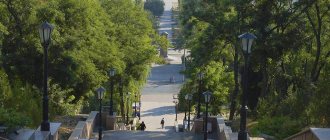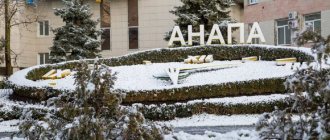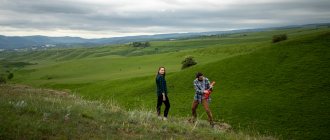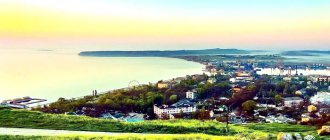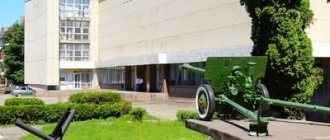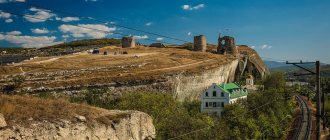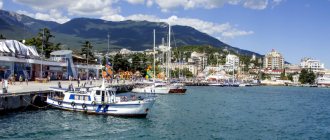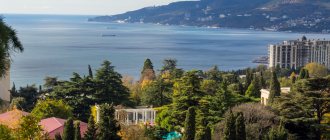This land has been inhabited since ancient times; during excavations, artifacts related to ancient Greek culture were found. In subsequent centuries, the Scythian tribes were replaced by Sarmatian tribes and ancient Slavs. During the Tatar-Mongol invasion, the territory was controlled by the Golden Horde; in the 15th century, the Don and Azov were captured by the Ottomans.
The Russian state had to defend itself, and only at the end of the 18th century, when it needed access to the sea to communicate with Western states, the young progressive Tsar Peter I undertook the Azov campaigns against Turkey. As a result of successful actions, a town arose in 1698, the place for which was chosen by the emperor, which became the first open sea port and the first naval base.
From the end of the 19th century, in the 20-30s of the 20th centuries, new industrial enterprises were created. Now it is the largest scientific, cultural, historical and industrial center in the region. In recent decades, much attention has been paid to the tourism business. Therefore, everyone will find something to see in Taganrog, where to stay and relax.
Beach holiday
Due to the shallow depth of the Taganrog Bay, the water warms up quickly. The only thing you need to know is that in August the sea blooms due to the activity of bacteria. But flowering does not cause harm to health, but at night it is very beautiful - the bacteria phosphoresce.
There are several beaches on the coast with equipped toilets and sports grounds. Here you can ride banana boats, rent a windsurf or catamaran. Entertainment programs are held - fun competitions, gaming competitions for children, discos. Central, Sunny, and Primorsky are especially popular. The coast is covered with sand, the bottom is first muddy, then turns into sand.
Sights of Taganrog
Sights of Taganrog. The most important and interesting sights of Taganrog - photos and videos, descriptions and reviews, location, websites.
- Last minute tours
to Russia
- Taganrog, st. Frunze, 20
the very bestRafailovich's house in Taganrog
Taganrog, st. Frunze, 20
This mansion is one of the most beautiful and oldest buildings in Taganrog. Built in the 1860s, it is included in the list of cultural heritage sites of the Russian Federation. To this day, the beautifully decorated building gives inspiration to artists.
- Taganrog, st. Port and Greek
the very best
Stone staircase in Taganrog
Taganrog, st. Port and Greek
The stone staircase is a real symbol of Taganrog, a favorite vacation spot for citizens and guests of the city. The staircase has been here for more than a hundred years and has always attracted people. The secret is simple: it itself is a most interesting architectural object.
- Taganrog, st. Chekhova, 69
the very best
Museum "Chekhov's House" in Taganrog
Taganrog, st. Chekhova, 69
A very small, neat and modest house, located in the depths of one of the courtyards of the wonderful city of Taganrog, may seem unremarkable at first glance. But, as with many things in our world, which at first seem insignificant.
- Taganrog, st. Admiral Kruys, 6
Water park "Lazurny" in Taganrog
Taganrog, st.
Admiral Kruys, 6 Taganrog is an ancient Russian port, one of the most beautiful cities in the Rostov region. The light salty breeze and the many entertainments typical of the south here remind you of the sea. But the warm waves of Azov are not the only water fun in these parts. - Rostov region, Neklinovsky district
Beglitsky Spit
Rostov region, Neklinovsky district
The Beglitsky Spit is a shallow part of the Taganrog Bay. It got its name from the village of Beglitsa located next to it. In 1930, a fishing collective farm was founded here, but later fishing was stopped due to shallowing. - Taganrog, Bogudonia
Bogdonia
Taganrog, Bogudonia
Fishermen have long lived in Bogudonia (or in the place where this area is now located). The brave “sea wolves” built houses as and where they had to, so today the area is an interweaving of narrow streets with small houses huddled together. - very bad
Taganrog, st. Oktyabrskaya, 9
Chekhov Gymnasium in Taganrog
very bad
1 reviewTaganrog, st. Oktyabrskaya, 9
Of course, one of the most famous natives of Taganrog, and, accordingly, a graduate of the city’s commercial classical men’s gymnasium, is, without a doubt, Anton Pavlovich Chekhov. It was within the walls of this educational institution that his teacher noticed the literary talent of the future great writer.
- Taganrog, st. Greek, 40
Palace of Alexander I in Taganrog
Taganrog, st.
Grecheskaya, 40 On one of the streets of Taganrog, namely Grecheskaya, there is a large house, which everyone here calls a palace. It is called so due to the fact that it was within its walls that all high-ranking officials who arrived or passed through the city stayed. - Taganrog, st. Frunze, 41
Alferaki Palace in Taganrog
Taganrog, st.
Frunze, 41 Alferaki Palace is located in the historical part of Taganrog on the corner of Frunze Street and Glushko Lane. The building stands out for its bright, Greek-inspired architecture: a classic antique portico with 4 columns and stucco decorations already in the Baroque style. - Taganrog, st. Petrovskaya, 89
Teacher's house in Taganrog
Taganrog, st.
Petrovskaya, 89 A modest one-story mansion in the very center of Taganrog is known locally as the Teacher's House, although in the list of architectural monuments it appears as the Commercial Court. The latter rented the premises from the heirs of M. Lascaraki, the head gardener of the city garden. - Taganrog, st. Greek, 56
Tchaikovsky House in Taganrog
Taganrog, st.
Greek, 56 About the building, which is now called the Tchaikovsky House, the great Russian writer Anton Pavlovich Chekhov wrote to his brother: “If I were rich, I would certainly buy the house where Ippolit Tchaikovsky lived.” Indeed, this house is very beautiful - Great
Taganrog, st. Admiral Kruys, 4k6
Eliseevsky Beach Taganrog
excellent
2 reviewsTaganrog, st. Admiral Kruys, 4k6
Taganrog stands on the shore of the bay of the same name in the Azov Sea, and it can also be called a resort. Eliseevsky Beach is considered one of the best in the city due to its infrastructure, proximity to the center and water park. It is located 2.5 km from the seaport, which means there will be no dirt from ships.
- Taganrog, per. Turgenevsky, 82
Cell of St. Paul
Taganrog, per.
Turgenevsky, 82 In the center of Taganrog you can see a small clay house that seems to have grown into the ground. This house enjoys special respect among the people. After all, the ascetic St. Blessed Pavel of Taganrog spent part of his life here, who is especially revered by the residents of the city. - Taganrog, st. Alexandrovskaya, 107
Round house in Taganrog
Taganrog, st.
Aleksandrovskaya, 107 This residential building in Taganrog has become one of the objects of pride for the townspeople and an interesting example of constructivism in architecture. It was built in the first half of the 20th century and became the first round house in the Soviet Union. - Neklinovsky district, village. Sambek
Memorial of Glory at Sambek Heights
Neklinovsky district, village.
Sambek For two years of occupation of the Azov region, Wehrmacht soldiers continuously dug trenches, concreted pillboxes and mined a 100-kilometer defense line on the right, high bank of the Mius River. The line they built seemed impregnable, but was broken through at the village of Sambek in August 1943. - Taganrog, st. Frunze, 80
Museum of Urban Planning and Life
1 review
Taganrog, st. Frunze, 80On one of the streets of the historical center of Taganrog there is the only Russian museum dedicated to urban planning and everyday life. Visitors are attracted, first of all, by its unusual building - the former mansion of grain merchant Yevgeny Sharonov, built in a modernist style in 1912.
- Taganrog, st. Alexandrovskaya, 100
Museum "Chekhov's Shop" in Taganrog
Taganrog, st.
Aleksandrovskaya, 100 The beautiful and hospitable southern city of Taganrog is full of interesting places and attractions. But still, for many travelers it is traditionally associated with the name of the great Russian writer Anton Pavlovich Chekhov. After all, it was here that he was born and spent his childhood and adolescence. - Taganrog, Komsomolsky square
Monument to Peter I in Taganrog
Taganrog, Komsomolsky Square
For the 200th anniversary of Taganrog, a bronze monument to the first Russian emperor, Peter I, was unveiled in the city. In the anniversary year, its foundation was laid, and 5 years later, in 1903, the finished sculpture was installed, the height of which with the pedestal is almost 9 m. - Taganrog, st. Petrovskaya, 104
Park of Culture and Leisure named after. Gorky in Taganrog
Taganrog, st.
Petrovskaya, 104 There are few city parks in Russia that are older than 200 years. One of them was founded in Taganrog in 1806 as an Apothecary Garden for growing medicinal plants. Then the status was upgraded to state-owned and opened to the public. A.P. Chekhov mentions evening walks in his stories and letters. - Taganrog, per. 1st Serf, 46
Petrovsky Barracks in Taganrog
Taganrog, per.
1st Serf, 46 The Petrovsky Barracks building is one of the oldest in Taganrog. Previously, they were part of the Trinity Fortress, which stood on the edge of Cape Taganiy Rog on the shores of the Azov Sea. The fortress itself was built at the beginning of the 18th century, and the barracks for the Taganrog regiment were built towards the end. - 1
- Next pageNext
Taganrog is an amazingly beautiful and interesting city (especially the so-called Old Taganrog).
There are many ancient mansions and palaces here that deserve the attention of architecture and history lovers. Take Frunze Street: on it is the most beautiful house in the city, the Rafailovich house, and next to it stands the Karaspasov house with a Chekhov outbuilding in the yard (Anton Pavlovich often stayed here), the Drossi house, where Chekhov played in amateur performances, the Rabinovich house with beautiful relief ancient Greek lions. All these buildings are included in the List of Heritage Sites of the Russian Federation. Handrin's one-and-a-half-story mansion on Aleksandrovskaya Street is also attractive; the wonderful and original Sharonov house with an acute-angled turret and lioness masks created by M. Vrubel, and wall paintings; houses of Ter-Arutyunov and Rubanchik. While walking around the center of Taganrog, you should definitely stop by the art cafe “Freken Bok”: they say that some come to the city specifically for this, and there are many good reasons for this.
Of course, one cannot ignore the classic, “big” sights of Taganrog, such as the Stone Staircase, the Church of St. Nicholas the Wonderworker, Bogudonia, the city government building, numerous museums and galleries, as well as wonderful green city parks. But in Taganrog there are also less flashy, but more unusual objects that no true traveler should lose sight of.
The city's monuments are especially interesting. Among the classic ones (Lenin, Pushkin, Peter I, Chekhov, as well as Gagarin and Korolev) you can see very charming and touching ones. For example, the sculptural composition “Egyptian Pyramid”, which is located at the entrance to the park named after. Gorky. The composition was cast in bronze and is an illustration of an episode of Chekhov’s “Kashtanka”: this is a pyramid that was “built” by a pig, a goose and a cat, as well as a dog standing next to it. Another interesting city sculpture is “Man in a Case,” created in 2010. It also illustrates one of Chekhov’s stories and represents the figure of teacher Belikov. The sculpture stands near the Taganrog Men's Classical Gymnasium, where Chekhov studied and where he found the prototype for the image of Belikov.
The monument to the amazing Faina Ranevskaya, born in Taganrog, was erected in 2008 in front of house number 10 on Frunze Street, where the future great actress grew up. The monument is a bronze sculpture more than 2 m high, created, like “Man in a Case,” by sculptor from Rostov D. Begalov.
In 2010, the coffee mojito “Freken Bock” took the prize as the most original signature drink at the interregional culinary championship.
While walking around the center of Taganrog, you should definitely stop by the art cafe “Freken Bok”: they say that some come to the city specifically for this, and there are many good reasons for this. The cafe is located on Turgenevsky Lane, at number 24. Firstly, the small building of the 19th century is quite interesting in itself. Secondly, the interior of the cafe is eye-catching, based on the works of Astrid Lindgren and decorated with a photo of F. Ranevskaya, who lived nearby (the cafe is even called a real monument to the great actress, in contrast to the “official” bronze one, which is placed nearby). Thirdly, this art cafe annually hosts Chekhov Book Festival events and meetings with authors, and the rest of the time there are readings, poetry evenings, theater performances and painting exhibitions. Fourthly, at one time our truly famous compatriots visited this cafe: Konstantin Raikin, Lev Durov, Vladimir Voinovich. Finally, the cafe is famous for its unique signature drinks, and its baristas regularly win something at regional and Russian competitions.
Interesting monuments
Tourists are attracted not only by the mild climate, warm sea, affordable prices for goods and services, but also by cultural and historical attractions.
Monument to Peter I
Erected before the revolution, the monument is dedicated to Peter I, the only one cast under the direction of the author - M.M. Antokolsky. Installed in 1903. The height of the figure is 3.44 m, the granite pedestal is 5.4 m high. The figure of the emperor is depicted in a uniform, at full height, holding a cane in his right hand and a sword in his left.
Monument to Alexander I
Another monument to the Tsar is Alexander I, erected in 1831. After the revolution, the monument was dismantled and repurposed for industrial needs. It was restored according to the surviving drawings with descriptions and reopened in September 1998. Here is also the Palace of the Royal Family, built in 1816, known as the place of death of Alexander I.
Depaldovskaya staircase
Depaldovskaya staircase is considered a symbol of the city and the most favorite walking place for local residents and guests, from any part of which a magnificent view opens.
The staircase owes its appearance to the merchant and philanthropist Depaldo, an ethnic Greek. He allocated enormous amounts of money for its construction, and by the fall of 1823 the project was ready. The 113 m long structure has 142 steps, the pedestrian part is made of Sarmatian limestone.
Monument of Military Glory
In the surrounding area, a monument to military Glory was opened in May 1980; it is located near the village of Sambek at the highest point. Dedicated to the defenders of this land - soldiers of divisions from Azerbaijan. The memorial consists of two concrete walls with figures of warriors.
In memory of Chekhov
The most popular and famous native of these places is the writer and playwright Anton Pavlovich Chekhov. His memory is immortalized in monuments, museums, and the names of various cultural and educational institutions.
What to see in Taganrog about his life and work:
- A small museum is located in the city itself. The room is small, there is a sign above the entrance: “Tea, coffee, colonial goods. There is a lot of interesting stuff inside - the interior is designed like a store from the late 19th century, with commercial equipment, an assortment of goods, and packaging dating back to that time. Here are the personal belongings of Anton Pavlovich and his relatives. You can still buy elite varieties of tea and coffee in the shop.
- "Chekhov's House" opened in 1926. The future writer was born here and lived for a little over a year. Located in a 30-meter-high plastered brick outbuilding built in the mid-11th century. For Chekhov's 50th birthday in 1910, a memorial plaque was installed on the wall of the house. The house has three rooms, a kitchen and a hallway. Museum workers carefully collected household items from the 19th century that miraculously survived the war. They managed to completely recreate the atmosphere in which poor merchant families lived. In the rooms - dining room, children's room, parents' bedroom you can see furniture, books, icons, kitchen utensils, tablecloths, paintings and photographs.
- A monument to the writer and several monuments were erected depicting characters from his works with names known from childhood: “Thick and Thin”, “Man in a Case” and others.
It will not be possible to see all the sights in Taganrog in one day, but it is possible to see places dedicated to A.P. Chekhov; they are located not far from each other.
Faina Ranevskaya
The famous actress F. G. Ranevskaya (maiden name Feldman) is also a native of these places. She was not lucky enough to play the main role in any film, but even the episodes with her participation were remembered by the audience forever. Residents erected a small monument to this woman in 2008, which became a local landmark. The artist is depicted almost life-size, with an umbrella and a hat. The opening took place in a solemn atmosphere during a theater festival dedicated to the memory of Faina Georgievna. The actress lived a long, often difficult life, often came to her hometown and helped the local theater.
An interesting fact, but the surname Ranevskaya is a pseudonym taken from Chekhov’s play “The Cherry Orchard.”
Alferaki Palace
What else is a must-see in Taganrog? Alferaki Palace is the most beautiful building, erected in 1848 by the wealthy merchant Alferaki, which has become one of the most striking attractions. Built in the New Baroque style - the walls and ceilings are richly decorated with stucco moldings made by the best craftsmen in Italy, luxurious handmade furniture. The architect was the famous and sought-after master Stackenschneider at that time.
Historical sites and museums
Museum "Chekhov's House"
Address: st. Chekhova, 69 Phone: Social networks: https://vk.com/tgliamz Opening hours: daily 10-00 – 17-00 Cost: entrance for an adult 80 rubles, for a student 50 rubles, for a schoolchild 40 rubles.
The outbuilding, where the famous Russian writer Anton Pavlovich Chekhov was once born, is now equipped as the Chekhov's House museum. It has several rooms: kitchen, living room, bedroom, children's room. Belongings of the Chekhov family and household items of that time are exhibited.
The family lived in the house for only 2 years (1859-1861). At the beginning of the 20th century, the building was bought and a museum was installed in it. The exhibition was first opened in 1926.
Not far from the outbuilding is another Chekhov museum. It is located in a former wine shop (at 100 Aleksandrovskaya St.). The writer’s father, merchant of the first guild Pavel Egorovich Chekhov, worked here.
Alferaki Palace
Address: st. Frunze, 41 Phone: , Website: https://www.tgliamz.ru/visitors/room3.php Opening hours: Tue-Sun 10-00 - 18-00, Mon - closed Cost: entrance for adults 100 rubles, for student 50 rub., for schoolchild 40 rub.
Alferaki Palace is part of the Taganrog Historical and Cultural Museum-Reserve. Named after the owner of the estate who built the palace - landowner, rich man and large merchant, Nikolai Dmitrievich Alferaki.
The palace building was built in 1848 by the architect Andrei Ivanovich Stackenschneider (St. Petersburg). The style is neo-baroque and imitation of Greek motifs (Alferaki is Greek by origin). The interior is decorated with secular frescoes.
In the 19th century, balls were held in the palace. After the death of N.D. Alferaki, when the estate was sold, the merchant community organized social concerts and commercial meetings here. Since 1927, the palace has become a museum.
Taganrog Art Museum
Address: st. Aleksandrovskaya, 56 Phones: (director), 8 (8634) 38-32-86 (accounting) Website: https://www.artmuseumtgn.ru/ Opening hours: Tue-Sun 10-00 – 18-00, closed Mon , the last Friday of each month is a sanitary day. Cost: admission for adults from 30 to 150 rubles, for students from 20 to 120 rubles, for schoolchildren from 20 to 70 rubles.
The museum was founded in 1848 as an art exhibition at the Museum of Local History on the initiative of Chekhov and Repin.
Since 1968, the collection has become an independent Art Museum. Today it is located in the estate of the merchant of the second guild A.Z. Khandrina, who in 1909-1913 served as the mayor of the city of Taganrog.
The modern museum collection exhibits paintings by Russian artists of the 18th and 19th centuries. Among them are masterpieces by Savitsky, Savrasov, Kuindzhi, Makovsky, Aivazovsky, Serov, Repin, Korovin, Tropinin, Surikov, Shishkin, Levitan.
In the courtyard of the museum there is an open-air exhibition of ancient cemetery sculptures.
Museum of Urban Planning and Life
Address: st. Frunze, 80 Phone: Website: https://tgliamz.ru/visitors/room1.php Opening hours: Tue-Sun 10-00 – 18-00, closed Mon Cost: entrance for adults 80 rubles, for students 50 rubles. , for a schoolchild 40 rubles.
The museum's collection is located in an ancient building built in 1912, the former mansion of grain merchant Yevgeny Ivanovich Sharonov.
The architect of the mansion is Fyodor Osipovich Shekhtel, who also designed the Yaroslavsky railway station in Moscow, the chapel at St. Michael's Church (in Taganrog) and the chapel at the Cathedral of Saints Peter and Paul (in Moscow). Viktor Vasnetsov and Mikhail Vrubel worked on the decoration of the external walls of the manor house.
The modern exhibition of the museum shows the history of the development of furniture and interior decor. Typical furniture of the 18th-20th centuries is exhibited here, as well as examples of furnishing rooms of representatives of different classes and professions. 4 halls of the history of urban planning were opened, the hall of Faina Ranevskaya, a native of Taganrog. There is a collection of glass products.
Literary Museum of A.P. Chekhov
Address: st. Oktyabrskaya, 9 Phone: , Website: https://www.tgliamz.ru/visitors/room4.php Opening hours: Tue-Sun 10-00 - 17-00, Mon - closed Cost: entrance for adults 100 rubles, for student 60 rub., for schoolchild 50 rub.
The museum is located in the building of the former men's gymnasium, where in 1868-1879. Russian writer Chekhov studied.
The museum exhibition is dedicated to the life of Chekhov and his work. Chekhov Gymnasium is one of the oldest schools in Russia. Founded in 1806, it was located in the house of the mayor of Campenhausen and only in 1843 moved to a new building.
Museum of Faina Ranevskaya
Address: st. Frunze, 10
The museum has been planned to open for 30 years. The idea of the museum was first expressed by Innokenty Smoktunovsky in 1987. Today the building is occupied by residential apartments.
On the street next to the house there is a sculpture of Faina Ranevskaya in the image of Lyalya, with an umbrella.
Museum of A. A. Durov
Address: per. A. Glushko, 44 st. Frunze, 80 Phone: Website: https://www.museum.ru/M871 Opening hours: Tue-Sun 10-00 - 18-00, Mon - closed Cost: entrance for adults 80 rubles, for students and schoolchildren 40 rubles .
The Museum of Circus Art was opened in 1988. The museum's exhibition is dedicated to the life of Anatoly Anatolyevich Durov (known as Durov Jr.), a representative of the Durov circus dynasty. The modern museum is located in one of the buildings purchased by Durov.
Among the exhibits of the museum exhibition: stuffed animals, family photographs, old circus posters, costumes, and a stylized arena. As well as stands with photographs of performances by other representatives of the circus dynasty.
Old station - Taganrog-2 station and monument to the steam locomotive
Address: pl. Vosstaniya, 1
The first Taganrog station was built in 1862 by the architect Zagoskin. Today it serves as a secondary suburban station.
An old steam locomotive is installed nearby - a monument to the heroic railway workers who died here in battle with the White Guards. Taganrog drivers directed the locomotive to the station building, where the headquarters of the White Guard was located.
The station is located in the historical part of Taganrog. 200 m from it is the Museum of Urban Planning, the house of Faina Ranevskaya, 600 m from the Museum “Chekhov’s Shop”.
Taganrog Museum of Aviation Technology
Address: st. Tsiolkovskogo, 42, Aerodrom-Tsentralny Telephone: Opening hours: Mon-Fri 8-00 – 14-00 Cost: entrance and excursion (2 hours) – 75 rubles.
The museum is located on the territory of a military unit, access to the museum is through the checkpoint at the Airplane monument on the street. Tsiolkovsky.
The Museum of Aviation Technology arose on the territory of an aircraft repair plant, next to the airfield. Here, in accordance with the Treaty on the Armed Forces of Europe, military aircraft were disposed of. Some of them, after removing the engines and combat systems, were left as museum exhibits in Taganrog.
The modern museum displays 12 types of aircraft. Among them:
- vertical take-off attack aircraft Yak-38;
- Su-7 fighter-bomber;
- the first supersonic fighter of the union, MiG-19;
- MiG-21 and MiG-23 fighters that fought in Afghanistan;
- supersonic interceptor MiG-25;
- Be-12 amphibious aircraft;
- Czechoslovak training aircraft L-29 and L-39.
And also the AN-2 maize truck, helicopters, aviation equipment - catapults, rockets, guns, bombs.
Cultural institutions
Where to go in Taganrog for art lovers?
Art Museum
Exhibits of the art museum are housed in the Handrin mansion. The collection contains more than 7,000 works - paintings, graphics, decorative and applied arts, and icon painting. The works of Shishkin, Aivazovsky, Kuindzhi, Repin, Roerich and many other masters are presented here. In the souvenir department you can buy postcards and photos describing the exhibits.
Drama Theater
The Drama Theater was founded in 1827; the troupe included serf actors and musicians; plays by Gogol, Shakespeare, and Griboedov were staged. Since 1944 it has been named after Chekhov. The repertoire includes productions for adults and children, works by classical and contemporary authors.
Parks and Recreation
Tourists can expect not only sights, but also active recreation. There are several parks, many squares and boulevards.
Park named after Gorky
On weekends, local residents enjoy spending time in the park named after. Gorky. A great place to relax with a child - here you can ride a horse or pony, wander through labyrinths or jump on a trampoline. There is a children's playground where competitions are held. Adults can play chess and have a cup of coffee in the cafe. According to reviews from Taganrozh residents, this is the most comfortable and beautiful place where you can relax, have fun, play sports and take wonderful photos of the city.
Water park "Lazurny"
The open-air water park "Lazurny" offers entertainment to city guests every day from the end of May to September. Located on the shore of Taganrog Bay. Evening performances and celebrations are often held on the territory of the aquatic complex, and promotions are offered. There are water slides of various heights - “space flight”, “water tube”, “cyclone”, swimming pools, and an area with sun loungers.
Parks and monuments, streets
Taganrog sea trade port
Address: Port Embankment, Marine Station Website: https://www.seaport.ru/
The commercial port of Taganrog is located on the coast of the Azov Sea, founded in 1698 as a naval base. Rebuilt in 1769 as a port fortress. Since 1784 it has been a Russian commercial port. Since 1991 – an international trade port.
Today, year-round navigation is provided here. During the cold season, two icebreakers operate. There are 7 berths for mooring ships. They accept ships with a draft of up to 5 m.
Sculptural composition “Romance with a double bass”
Address: Pushkinskaya embankment, square
The monument was created based on a humorous story by Chekhov, who was born and raised in Taganrog. The author of the composition is a modern sculptor from Rostov-on-Don Dmitry Ryndin.
According to the humoresque's plot, a girl whose clothes were stolen while swimming hid in the case of a double bass. While the owner of the double bass was looking for suitable clothes, the musician’s friends took away the case with the girl.
Monument to Taganrog underground fighters “Oath of Youth”
Address: per. Spartakovsky, 1
The sculptural composition “Oath of Youth” is dedicated to the anti-fascist youth organization that worked in Taganrog during the occupation of 1941-1943. The monument was erected to mark the 30th anniversary of the liberation of the city. Authors: Vladimir and Valentina Grachev.
The installation site for the sculptures is the site in front of the Chekhov gymnasium. It was former high school students who became participants in the underground youth organization.
Sculptural composition “Mercury” (or “Palm with Hermes”)
Address: per. Gogolevsky, 4a, main entrance to the Rainbow market
The monument was opened in 2012 to mark the 20th anniversary of the shopping complex at the Raduga market. The author is modern sculptor Dmitry Ryndin.
The double name of the monument is associated with two variants of the name of the patron of merchants. The Greeks have the god of trade and profit - Hermes, the Romans - Mercury.
Old sundial
Address: st. Greek, near the Stone Staircase
The 1833 sundial is the oldest sundial in Russia. After restoration in 1972, the gnomon turned out to be tilted at the wrong angle, not corresponding to the latitude of the area. Therefore, the clock readings lost their accuracy.
New sundial
Address: st. Petrovskaya, entrance to the park named after. Gorky
A new sundial was installed in 2000. Manufactured with funds from the Lemax enterprise, which produces heating equipment in Taganrog.
Depaldovskaya staircase
Address: between st. Greek and Pushkin Embankment
Depaldova, or stone staircase, was built in 1822.
Patron and merchant, hereditary Greek Gerasim Fedorovich Depaldo bequeathed 15 thousand rubles for the arrangement of the staircase descent.
A 115 m long staircase connects Grecheskaya Street with the city Embankment. The author of the project is Italian Franz Boffo. He used a technique that allows him to visually change the appearance of steps and flights. From top to bottom, the staircase appears the same across its entire width, which was achieved through different heights of steps (there are 190 in total).
Depal's staircase in Taganrog served as a prototype for the Potemkin Descent in Odessa.
Novo-Bessergenovsky source
Address: st. Sadovaya
The source consists of five springs. Their flows form a stream that flows along the bottom of the ravine and flows into the Taganrog Bay. Thanks to the fast flow, the water flow does not freeze in winter when it is cold. In summer – maintains a cool temperature.
Not far from the source there is the Church of the Icon of the Mother of God and the Topol sanatorium.
Accommodation
There are enough places to stay here, there are both budget and expensive hotels and hotels:
- The Izvolte Hotel is a great place. It has standard apartments, “superior standard”, “junior suite”. There is a restaurant with varied cuisine and a bar. The rooms have TV, Wi-Fi, air conditioning, safe, hairdryer. The cost of the “standard” is from 2100 rubles.” Luxury" - from 3800 rubles.
- Inexpensive guest house "Central" - according to reviews from vacationers, it is clean and comfortable, helpful staff and excellent food. Located a 5-minute walk from the beach, there is private parking, barbecue area, restaurant and laundry on site. You can use free Wi-Fi, air conditioning, and an electric kettle. The fund consists of “economy” and “standard” rooms. Prices - from 650 to 1200 rubles.
- The luxurious Boutique Hotel “Varvatsi” has an excellent location, no more than two minutes walk to the embankment. Features free Wi-Fi, air conditioning, flat-screen satellite TV and minibar. The interior is decorated in a classic style in pastel colors. Price - from 4500 rubles, breakfast included.
Road
How to get to Taganrog? From Moscow you can get there by plane, train or bus:
- By plane, flight Moscow - Rostov-on-Don, then (60 km) by train, bus or taxi.
- Trains depart daily from several Moscow railway stations. The average cost of tickets is 1600 rubles. Travel time from 15 hours.
- By bus - from the Central Shchelkovo bus station, transport arrives at the bus station. Passengers spend 16-18 hours on the road, sometimes more. A one-way ticket costs from 1,350 rubles.
Unique attractions and the opportunity to spend interesting leisure time for adults and children, a mild climate, inexpensive products and a warm sea make a holiday on the coast of Taganrog Bay calm, educational and healthy.
